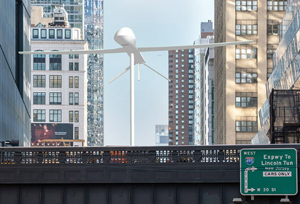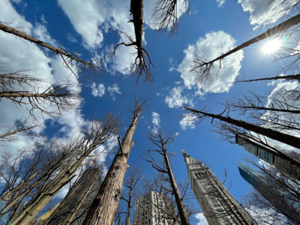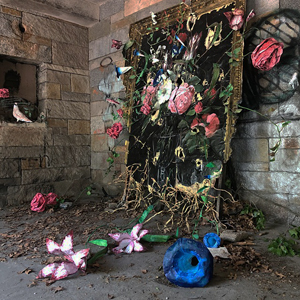Heading for You
John Haberin New York City
Summer Sculpture 2021
Relish the irony that sound art shares parkland with a drone, but this drone is not a dull hum. A windowless white airplane seems to swoop down on Tenth Avenue, heading, quite possibly, for you. New York summer sculpture is like that, coming from seemingly out of nowhere to enliven the long, lazy months of a noisy, hyperactive city.
It took me to Socrates Sculpture Park, where Guadalupe Maravilla and his Mexican grandparents are stirring the pot. It took me to the High Line for the drone by Sam Durant and "The Musical Brain." It took me to Madison Square Park, where Maya Lin has seen the ghost of the Pine Barrens, and to City Hall Park, where Melvin Edwards rediscovers Modernism and refuses an African American's chains. It took me to Riverside Park for miles of art, in "Re:Growth," and to the New York Botanical Gardens for Yayoi Kusama. But then who needs an excuse to explore New York in summer? I report separately on Alex Da Corte and the Met's roof. 
Your brain on drones
Sam Durant is only the second to command the "spur" of the High Line crossing Tenth Avenue, after Simone Leigh. His airplane gains as art from its setting and sleek exterior, but you still have to be sufficiently right-thinking to see a drone as ominous rather than a pricy child's toy. Also in the elevated park, a tree sprouts from an upside-down smokestack for Ibrahim Mahama, as an industrial neighborhood's very own Lady Liberty, while Hannah Levy leaves a Retainer—and she does not mean the restraining action of the surveillance state. Who needs braces, when one can have polished marble like this for teeth? By comparison, a show of sound art is a recipe for invisibility, for its appeal is not to the eye. All the more so amid the sounds of the great outdoors, with "The Musical Brain."
Naama Tsabar hopes to catch the eye with a monumental metronome, David Horvitz with former railway spikes for bells, and Mai-Thu Perret with chimes in the shape of vital organs. Raúl de Nieves models a glitzy, gaudy, life-size musical performer for its, er, "magical splendor," Rebecca Belmore and Osvaldo Yero a mythical siren luring you to your fate, while Guillermo Galindo demands attention for a treacherous border crossing, with a water drum shot full of holes as his Fountain of Tears. But then sound art goes silent, and magic or splendor is hard to find. Antonio Vega Macotela records silence, thirty seconds of it, on a disk that looks already obsolete. You may find yourself attending more to sound—not of art, but of extravagant real estate under construction. Vivian Caccuri directs the eye to just that, covering his Portuguese "baile funk sound system" (a throbbing bass line to you) with reflective glass.
When Paul Ramírez Jonas called his work in Socrates Sculpture Park last year Eternal Flame, little did he know. He meant it as a contribution to "Monuments Now" and to the park itself—with a classical column housing BBQ pits. He also expected it to be gone in March, and here it is, not eternal (though it will linger at least through the coming winter's Socrates Annual and the following summer), but kept on for those glorious summer days on the Queens waterfront. A sign for "BBQ Rules" takes on new meaning. It does rule, and so does the community. The monument also helps fill out this year's summer sculpture, by Guadalupe Maravilla, who takes the long view, too.
Where Ramírez Jonas offers a monument to his neighbors, Maravilla remembers his ancestors. He calls his work "Planeta Abuelx," with an eye to Mother Earth but looking past anyone's mother to his Mexican grandparents, ending in a woke gender-neutral X. They appear on the Broadway billboard above the park's entrance, stirring a pot, as hands bring a pencil and a lightning bolt—perhaps the hands of the artist. He calls an abstract drawing on the grass his Tripa Chuca (or "rotting guts"), but rest assured: its silvery white will not lend itself to grilling.
The show's centerpiece may look unappetizing, too, and its mythic aspirations a bit much as well. Coral inspires its crusty metal forms, but for him coral is no more than natural growth, and the forms include the Three Sisters of corn, squash, and beans. (They appear on the billboard, too.) If the work, Disease Throwers, sounds threatening itself, Maravilla is a cancer survivor, and he means those healing plants to throw disease to the winds. Twin gongs bring healing sounds, and one can sit on his drawing, within a shining circle of metal rope, for a sound bath. Had the three sisters in Macbeth been so comforting, Macbeth would have lived to a ripe old age as a noble lord.
Doors by Sam Moyer across from the Plaza Hotel may seem impenetrable, given their weight. Yet they open onto the imagination and the city, through September 12. He lends material quarried from New York itself a painter's impasto, much at his Chelsea gallery. In front of Rockefeller Center, succeeded by an even more hideous contribution by KAWS and the KAWS collection, Sanford Biggers wants his art to be weightier still. An enthroned figure with stereotypical African features and of uncertain sex bears the gilded torch of Lady Liberty rather than a scepter, as Oracle. At nearly three stories tall, it might feel every right to mock the artist's pretensions and my derision.
Sugar sands and broken chains
They call it "sugar sands." The Pine Barrens are that paradox, a sandy ecosystem and a barrens that is not altogether barren. It is admired and undeveloped, in part because so little will grow there. It may be the best thing the northeast corridor has going, so close to New York and Philadelphia,  and yet here, too, trees are dying as humanity's footprint intensifies the salty, acidic habitat. Maya Lin has hauled forty-nine of them from New Jersey to Madison Square Park, where the innocent eye might not know that they are dead. A site for summer grass and summer sculpture has become her Ghost Forest.
and yet here, too, trees are dying as humanity's footprint intensifies the salty, acidic habitat. Maya Lin has hauled forty-nine of them from New Jersey to Madison Square Park, where the innocent eye might not know that they are dead. A site for summer grass and summer sculpture has become her Ghost Forest.
They arrived in May, well in time for summer—not pines, but Atlantic white cedars. They stood out from their gnarly neighbors only by their slim, pale trunks and few remaining bare branches. Before their departure, as leaves fall, it may be other trees that have one seeing ghosts. And their impact depends on how little Lin has done, from an artist who knows when to hold back. She made her name as still a student with the Vietnam War Memorial in Washington, where she declined to erect a statue or a column. Her transformations of a trolley repair shop into SculptureCenter and a workshop into the Museum of Chinese in America left basement tunnels and well enough alone.
Lin's small-m minimalism brings out the cost to a nature preserve of increasingly salty sands. It may serve the cause better than her past work or that of Jumana Manna on the theme of climate change—as less allusive, but also less arty. It casts a cold eye over the old advice to plant a tree. She does so, forty-nine times over, and it will not bring a single one to life. The square was barren enough in the 1970s, when it mostly housed the homeless. Only summer will tell whether the work will flourish enough.
Melvin Edwards calls his contribution to City Hall Park "Brighter Days," through November 28. Edwards is still flourishing at age eighty-four. (Not that he can top Carmen Herrera, who had the park at over a hundred for New York summer sculpture in 2019.) He is also about as far from tributes to unspoiled nature as art can get. In much of his sculpture, rough edges and rust colors call attention to his work as a welder. Quite as much as Minimalism, he also points to the thing itself and its weight.
Here those characteristics are gone. Call it a loss, but it gives Edwards his rightful place in modern sculpture. Even in a show about black power at the Brooklyn Museum, he insisted on an African American's presence in abstract art. Here four works have the burnished finish of David Smith, with disks and other geometric shapes like Smith's sculpture at Storm King Art Center as well. A friend mistook the work for Smith's—and her husband was an African American painter, Eugene J. Martin. But then Smith had worked as a welder in industry, too.
Edwards does have a political side, with shapes like manacles for a chain gang or a slave. Here the silvery work enlarges those shapes while abstracting them away—with one as Song of the Broken Chains. A fifth sculpture suspends slim chains from red ovals on the ground, and the last could almost rock back and forth, too, but in massive iron brown. They also play well with the site. The work on pedestals follows the central walkway, while the rockers rest on grass. No six works can serve as a retrospective, but they are enough to show once again that there is no greater living sculptor.
Re:live
When New York summer sculpture takes to the parks, it takes art back to nature, right? Perhaps, but then it spotlights the parks themselves as useful and as works of art. "Re:Growth" spans nearly five miles of Riverside Park— from its wide-open southern extension to the twists, turns, foliage, and facilities north of 72nd Street. Curated by Karin Bravin of BravinLee Programs, it is not always up to competition from its surroundings. It does, though, ask just how hospitable nature and humanity are to one another. That "Re:" brings hope of rebirth and reflection, but only after a multitude of human sins.
from its wide-open southern extension to the twists, turns, foliage, and facilities north of 72nd Street. Curated by Karin Bravin of BravinLee Programs, it is not always up to competition from its surroundings. It does, though, ask just how hospitable nature and humanity are to one another. That "Re:" brings hope of rebirth and reflection, but only after a multitude of human sins.
Much of "Re:Growth" is hard to locate, even with an online map. Works merge with their setting on both sides of the West Side Highway, along the Hudson River and along Riverside Drive. They take repeated crossings under the highway—those, too, a challenge to locate and a still greater challenge to climb or descend. Gaps between works can run to over a mile in the park's barren north end. A more concentrated siting would have paid off big time. All I can say is that I did my level best.
Still, the difficulty points to the show's ambition, even beyond its size. Besides sculpture, it has room for banners along a pier by Dahlia Elsayed and paintings by Rico Gatson, running the length of a ball field in Pan-African colors. Shuli Sadé brings art directly to your phone, as Upstream Downstream—although you may wonder why you walked so far for augmented reality. (And here you thought you could still work from home.) Joiri Minaya leaves her mummified body here and there, in photos of performance. Freestanding sculpture comes as a relief, like ancient "Rhoman" statues as imagined by Joshua Goode or honeycombed steel by DeWitt Godfrey, not least because you can see it from a distance.
Others stick to growth, like glitzy pretend spores by Sui Park and prints of leaves on steel by Letha Wilson. Wendy Letven means her curves to evoke dappled light and swirling winds. Marry Mattingly fronts a "reading room" with actual plants, the better for reading about nature. But then nature may have you wishing for shelter. Glen Wilson prints photos of mail carriers on the fence of an abandoned ballfield#8212;because they keep at it, in rain, sleet, snow, or dark of night. And humanity plays some nasty tricks on nature in return.
Niki Lederer constructs her petite "snow squall" and "swailing" (meaning low-lying wetlands) from plastic bottles, while Jean Shin covers rocks with bottle caps (naturally enough, from Mountain Dew), like moss but more glittery and gleaming. Toxic waste may have a place after all. Yet the greatest artifice may be the easiest to pass unseen. Artificial flowers from Valerie Hegarty appear to tumble out of a Dutch still life and onto the floor of a park building. Its gated stone could belong to a fortress or a prison. Her "nature morte" could be all the deader and darker for it—or all the more unruly and alive.
Art in Brooklyn Bridge Park heads north to Dumbo—the part that, barely a decade ago, was the park and its home for sculpture. Claudia Wieser tiles her five plinths and pedestals with geometric patterns, glimpses of New York and a family vacation, and fragments of Greek and Roman Sculpture. It may speak more to longing than to coherence, but it is only her Rehearsal. Nothing at all made it this summer to the Park Avenue median strip, but Yayoi Kusama brings her hall of mirrors to the New York Botanical Gardens, along with her cute-and-cuddly cohort of polka dot plants and animals. It would be heartless not to smile and foolish to say more. But then one might say the same for summer sculpture in New York.

Guadalupe Maravilla ran in Socrates Sculpture Park through September 6, 2021 while Paul Ramírez Jonas for now continues, Sam Moyer in Doris C. Freedman Plaza through September 12 and at Sean Kelly through April 24, Maya Lin in Madison Square Park through November 14, Melvin Edwards in City Hall Park through November 28, "Re:Growth" with BravinLee Programs in Riverside Park through September 13, and Yayoi Kusama at the New York Botanical Gardens through October 31. "The Musical Brain" ran on the High Line with Sam Durant and Hannah Levy through March 31, 2022, Claudia Wieser at the foot of Washington Street in Brooklyn Bridge Park through April 17. I continue to follow summer sculpture as in past years going back to summer 2003 and continuing through summer 2020, its extension into fall, summer 2022, summer 2023, and summer 2024.




